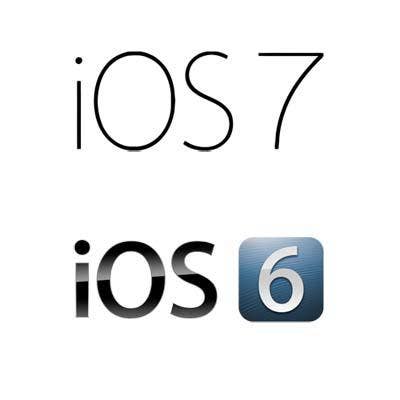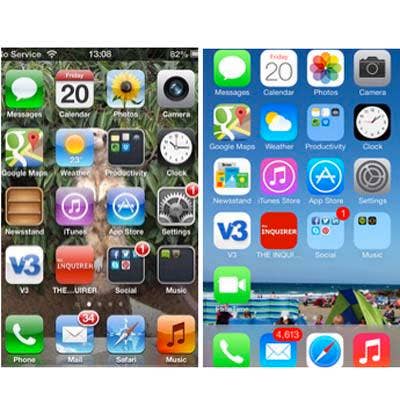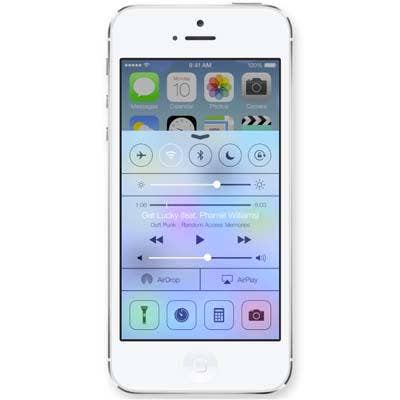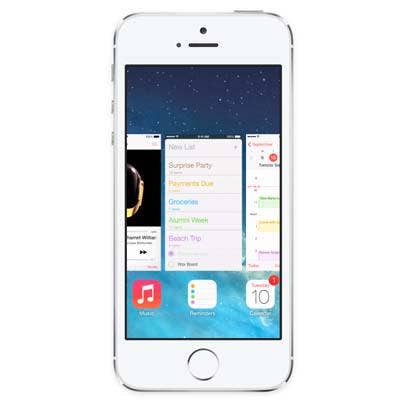Head To Head: iOS 7 vs. iOS 6

Apple's New Best OS
With more than 9 million new iPhones sold so far, Apple's iPhone 5S is its most successful ever, and its best challenger to Samsung's Galaxy S4. With all the fanfare over Apple's new hardware, the software sometimes gets short shrift. But not here. Apple's latest mobile operating system -- iOS 7 -- is great-looking, fast and keeps people's most common features much closer at hand. Here's a look at some of the highlights as compared with what came immediately before in iOS 6.

'Cartoony' Icons
The first remarks from most people we've spoken with about iOS 7 have to do with the "cartoony" look of its icons. Apple has simplified the icon graphics in iOS 7 (at near left) and removed their reflectivity. This leaves them with a markedly 2-D appearance. A good example is the shiny purple iTunes icon in iOS 6 (at far left), which looks like it's made of curved glass. In fact, the entire iOS 7 interface has been flattened, simplified and made more plain (see the next slide). The change probably deserves at least partial credit for iOS 7's much snappier performance. Apps launch and run faster and crash less often (or not at all) and everything in iOS 7 just feels more solid and stable, according to user reports we've received. On the 64-bit iPhone 5S, iOS 7 and its native apps are all running in 64-bit mode, which Apple says delivers a 2X improvement over the iPhone 5 and a 40X improvement compared with the original iPhone.

Flatter User Interface
We're all in favor of simplicity, particularly when it delivers faster performance. But we might have thought that the simplified interface in iOS 7 would have delivered more screen real estate, too. Remarkably, it did not. When displayed side-by-side, the same app screen displays the same amount of information regardless of OS. Notice that despite the disappearance in iOS 7 (near left) of the top status bar, smaller fonts and thinner NavBar (top) and ToolBar (bottom), the amount of displayed app content is about the same (or even slightly less) in iOS 7.

Control Center
Apple has finally added a way to access often-used functions without diving into the Home Screen's icon pool and fishing around for the Preferences panel. Swiping up from the bottom in iOS 7 now invokes the Control Center, a translucent panel with buttons for toggling Airplane Mode, Wi-Fi, Bluetooth, Do Not Disturb and Rotation Locking. There's also a slider for screen brightness, a media player with AirPlay and AirDrop buttons (for iPhone/iPod Touch 5 or later and iPad 4 or later) and four fixed-function buttons for flashlight, calendar, calculator and camera. Since this is all brand new to iOS 7, there's nothing to compare with iOS 6. Incidentally, Android has offered such functionality from the start, and Android developers have steadily improved it in each subsequent revision. But Apple differentiates its Control Center with the ability to be disabled from the lock screen, from within apps or both (in which case it's only accessible from the Home Screen).

More App Control
Continuing to follow Android's lead, Apple has improved the ability in iOS 7 to page through running apps. Double-pressing the home button now invokes a scrollable carousel of all running apps that can be brought into focus with a tap or killed by swiping up. Apps are represented not as simple icons (as in prior iOS versions) or as static app screens (as in Android), but as a combination of the two. These semi-living screens show real data and allow peeks into other running apps without actually switching into them. Pressing the Home button again (once) returns focus from whence it came. The new Safari also is vastly improved. It now employs a revolving card-like interface for scrolling through open browser pages or tabs with no more eight-card limit. And a single text bar accepts URLs or searches (a la Chrome).

Bottom Line
Apple continues to raise the bar for intuitiveness and usability of its operating system, even though some of the ideas are clearly coming from the Android side. With quick access to oft-used functions through the new Control Center and the ability to page through or peek into live running apps, iOS 7 is the most capable version yet for helping people stay productive. This one's a keeper.